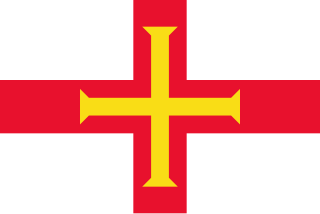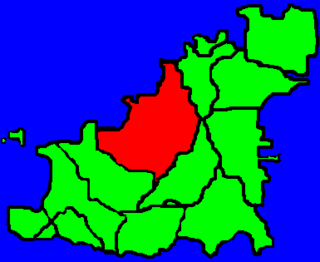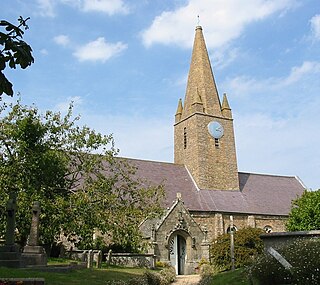
St Peter's College is one of the constituent colleges of the University of Oxford and is located in New Inn Hall Street, Oxford, United Kingdom. It occupies the site of two of the university's medieval halls, dating back to at least the 14th century. The modern college was founded by Francis James Chavasse, former Bishop of Liverpool, opened as St Peter's Hall in 1929, and achieved full collegiate status as St Peter's College in 1961. Founded as a men's college, it has been coeducational since 1979.

The flag of Guernsey was adopted in 1985 and consists of the red Saint George's Cross with an additional gold Norman cross within it. The creation was prompted by confusion at international sporting events over competitors from Guernsey and England using the same flag. It was designed by the Guernsey Flag Investigation Committee led by Deputy Bailiff Sir Graham Dorey. The flag was first unveiled on the island on 15 February 1985. The gold cross represents William the Bastard, Duke of Normandy. William purportedly was given such a cross by Pope Alexander II and flew it on his standard in the Battle of Hastings. Since 2000, a red ensign with the cross in the fly has been used as the government's civil ensign and as a blue ensign.

Saint Peter Port Harbour is located in Saint Peter Port, Guernsey. It was a natural anchorage used by the Romans which has been changed into an artificial harbour that is now the island's main port for passengers. Loose cargo, liquids and gas are shipped to and from St Sampson's harbour.

William Strickland, was a noted architect and civil engineer in Philadelphia, Pennsylvania, and Nashville, Tennessee. A student of Benjamin Latrobe and mentor to Thomas Ustick Walter, Strickland helped establish the Greek Revival movement in the United States. A pioneering engineer, he wrote a seminal book on railroad construction, helped build several early American railroads, and designed the first ocean breakwater in the Western Hemisphere. He was elected as a member of the American Philosophical Society in 1820.

St Sampson is a parish of Guernsey, an island in the Bailiwick of Guernsey, directly north of St Peter Port. It is on the north-west and north-east coasts of the island and is split into two sections, intersected by Vale.

Castle Cornet is a large island castle in Guernsey, and former tidal island, also known as Cornet Rock or Castle Rock. Its importance was as a defence not only of the island, but of the roadstead. In 1859 it became part of one of the breakwaters of the Guernsey's main harbour, St Peter Port's harbour.

Castel is the largest parish in Guernsey in terms of area.

The Royal College of Elizabeth, better known as Elizabeth College, is a co-educational independent school in Saint Peter Port, Guernsey. One of the earliest members of the Headmasters' and Headmistresses' Conference (HMC), it is a public school in the British sense of the term. Founded on 25 May 1563 by royal charter from Queen Elizabeth I, the school is one of the oldest in the British Isles and is the oldest public school in the Channel Islands.

The Christchurch Town Hall, since 2007 formally known as the Christchurch Town Hall of the Performing Arts, opened in 1972, is Christchurch, New Zealand's premier performing arts centre. It is located in the central city on the banks of the Avon River overlooking Victoria Square, opposite the former location of the demolished Christchurch Convention Centre. Due to significant damage sustained during the February 2011 Christchurch earthquake, it was closed until 2019. Council staff initially recommended demolition of all but the main auditorium, but at a meeting in November 2012, councillors voted to rebuild the entire hall. In 2020, the town hall was registered as a Category I heritage building.

Croome Court is a mid-18th-century Neo-Palladian mansion surrounded by extensive landscaped parkland at Croome D'Abitot, near Upton-upon-Severn in south Worcestershire, England. The mansion and park were designed by Lancelot "Capability" Brown for the 6th Earl of Coventry, and they were Brown's first landscape design and first major architectural project. Some of the mansion's rooms were designed by Robert Adam. The Church of St Mary Magdalene that sits within the grounds of the park is owned and cared for by the Churches Conservation Trust.

The Norman-era Minster Church of St Nicholas in Great Yarmouth remains, due to its floor-surface area, England's third largest parish church, behind Beverley Minster in East Yorkshire and Christchurch Priory in Dorset. It was founded in 1101 by Herbert de Losinga, the first Bishop of Norwich, and consecrated in 1119. Since its construction, it has been Great Yarmouth's parish church. It is cruciform, with a central tower, which may preserve a part of the original structure. Gradual alterations effectively changed the form of the building. Its nave is 26 feet (7.9 m) wide, and the church's total length is 236 feet (72 m).

J. W. Walker & Sons Ltd is a British firm of organ builders established in 1828 by Joseph William Walker in London. Walker organs were popular additions to churches during the Gothic Revival era of church building and restoration in Victorian Britain, and instruments built by Walker are found in many churches around the UK and in other countries. The firm continues to build organs today.

Reading Town Hall is the town hall in the town of Reading, in the English county of Berkshire. The town hall was built in several phases between 1786 and 1897, although the principal facade was designed by Alfred Waterhouse in 1875. Situated close to the site of Reading Abbey, it is adjoined to the north by the Hospitium of St John and to the south by St Laurence's Church.
Daniel de Lisle Brock (1762–1842) was Bailiff of Guernsey from 1821 until his death 1842.

St Lawrence Parish Church is an active Anglican church in York, England. It is situated in Lawrence Street, just outside Walmgate Bar.

The Town Church is also known as the "Parish Church of St Peter Port", "Sancti Petri du Portu" and "Town Church of St Peter, Apostle & Martyr".

Barony Hall, also known as Barony Church, is a red sandstone Victorian neo-Gothic-style building on Castle Street in Glasgow, Scotland, near Glasgow Cathedral, Glasgow Royal Infirmary and the city's oldest surviving house, Provand's Lordship. The original or Old Barony Church was built as a part of the Barony Parish in Glasgow by architect, James Adams. It opened in 1799 and served ceremonial and other congregational purposes. The replacement for the old building was designed by J. J. Burnet & J. A. Campbell and raised in 1889, and incorporated architectural artifacts from the old church and a number of other relics.

St Martin's Parish Church, Guernsey is also known as the Saint Martin de la Bellouse and is located in a dip in an ancient village, in the parish of Saint Martin, Guernsey.
John Wilson was a Clerk of Works for the Board of Ordnance who became one of the most celebrated architects in the island of Guernsey for the buildings he designed there between 1813 and 1831.


















